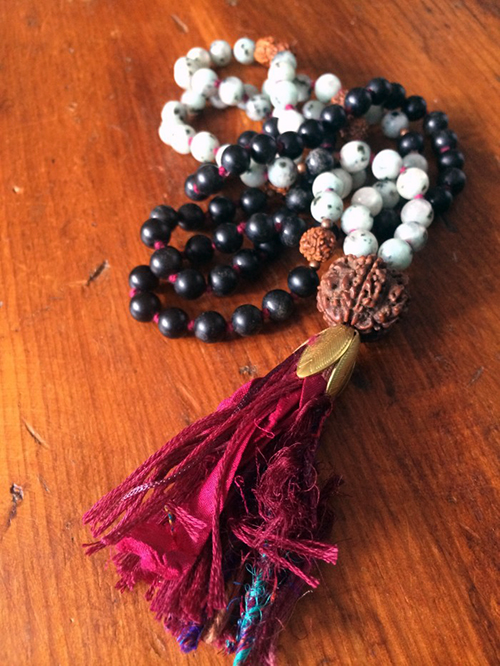Spring is a time of renewal. It offers us a chance for a fresh start, a time for awakening, for blooming.
By now you have probably been inundated with the myriad benefits of a meditation practice. Meditation increases cardiovascular health, awareness, self-acceptance, and perspective; reduces stress; and makes you an overall happier person. All you have to do is sit still on a cushion and breathe, but it is easier said than done. It can be difficult to find yourself in a quiet environment. You may feel uncertain that you are doing it right, finding yourself frustrated with a wandering mind. Meditation may feel overwhelming, as simple as it may be.
At first, doing something on a regular basis might be accomplished best by prodding and pulling, but before you know it, a new habit becomes the norm, and a source of comfort. Having a community or supporters around you is a great way to realize a new practice.
This is my challenge to you, Peaceful Dumplings: Meditate for ten or more minutes everyday, beginning on March 21st, the Spring Equinox, and lasting 28 days for the whole cycle of the moon (ending April 17). Join by signing up on this Facebook page. Share your experiences with others, and see what opens up. Maybe you will find a new level of calm. Maybe you will actually feel uncomfortable with insights and emotions that come up to the surface. Invite everyone you know to join!
Things to consider in starting a practice:
Designate a place:
You don’t need a special cushion or an altar–they can be incorporated in your practice if you want, but are not necessary. Just choose a place where you will be able to sit with minimal distraction.
Set an alarm:
I use my handy-dandy iPhone. It is important to set an alarm, so that you do not wonder about the time. It is one less distraction, when you can keep your mind from wondering, “How much longer do I have?”
Set a regular time:
Stick to a time, if possible. Always in the morning, always at night, or whichever time serves you best. This will make your practice habitual.
Posture:
Sit up straight, stacking your vertebrae tall and long over your sits bones, allowing the diaphragm to work at capacity. Relax your shoulders. Place hands on your thighs. It doesn’t matter if your hands are up or down; whatever works for you, so you can sit still. Eyes can be open or closed. Cushions help, but you can sit directly on the floor, or even in a chair.
Types of meditation to consider:
Anapana:
Focus on the skin below the nose. Observe your breath moving over that space. Observe the little hairs as they move. Notice moisture, temperature. As the mind wanders, label the thoughts as “thinking,” and come back to the lip. Your mind will wander a lot. It is okay. The practice is in bringing the mind back to the moment.
Vipassana:
Scan the sensations of the body, beginning below the nose, over the crown, the cheeks, necks, chest, back, belly, as so on. Work you way throughout the body, observing sensations. Feel where your body touches cloths, the ground, air, and other body parts. Simply observe discomfort as a sensation, and try your best not to change positions (if you are in pain, but all means move). If you mind wanders, gentle label the thoughts as “thinking,” and come back to scanning the body for sensations.
Loving-Kindness (Metta):
Think of yourself. Think of your smiling face. Say aloud or in your head: May I be happy. May I be well. May I be safe. May I be peaceful and at ease.
Think of someone you love, see them smiling in your mind and say: May (loved one) be happy. May (loved one) be well. May (loved one) be safe. May (loved one) be peaceful and at ease.
Third, think of someone you feel neutral for, such as an acquaintance, or someone you see around town but do not really know. This can also be a group of people, or evn an animal! Bring their smiling faces to mind and say, “May (neurtal person) be happy. May (neutral person) be well. May (neutral person) be safe. May (neutral person) be peaceful and at ease.
Finally, think of someone who is a thorn in your side. Perhaps someone you consider an enemy. Bring their smiling, softened face to mind and say, “May (enemy) be happy. May (enemy) be well. May (enemy) be safe. May (enemy) be peaceful and at ease.
This meditation is meant to crack your heart open and bring about compassion.
Mantra:
A mantra is a phrase or word used over and over. It can be “aum,” or “I am loving awareness.” You could also try, “I am good enough.” A great tool in mantra mediation is mala beads, which count the times a mantra is said, at 27, 54, or 108 beads at a time. Here is a detailed article on how to use a mala necklace.
There are many, many more techniques. You can listen to guided meditations here, and you can even do a walking mediation. Play around with different techniques, finding what works. Then, stick with it, staying vigilant to your practice. It is only twenty-eight days! Experience the benefits of meditation for yourself.
Related: My Vipassana Meditation Experience
How I Lost Weight Through Zen Meditation
How to Do Visualization Through Mandalas
__
Photo: Jessica Riley-Norton





